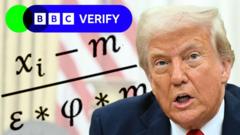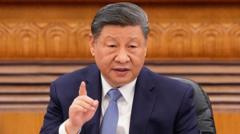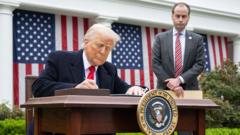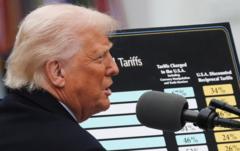President Trump's latest tariffs signal a significant shift in global trade dynamics, raising concerns among allied nations and potentially igniting wider economic repercussions.
Escalating Tariffs: America's Trade Allies Left in the Lurch

Escalating Tariffs: America's Trade Allies Left in the Lurch
With the announcement of new tariffs, President Trump's protective policies deepen divides with international partners.
April 2, 2025, 5:41 p.m. ET
President Trump made headlines today after unveiling a series of aggressive tariffs aimed at numerous countries around the world, further distancing the United States from its traditional allies and reshaping the international trading landscape. Under the newly proposed measures, the European Union anticipates facing a 20 percent tariff, while China will be hit with an additional 34 percent on top of previous levies.
Economist Eswar Prasad from Cornell University warned that "the magnitude and extent of these tariffs will echo through the global economy," suggesting that this move propels the U.S. towards an era characterized by heightened protectionism.
Notably, Mexico and Canada, significant trading partners of the United States, will not experience any additional tariffs beyond those that are currently enforced regarding vehicles, vehicle parts, and metals as dictated by the U.S.-Mexico-Canada Agreement. The new tariff framework includes a standard 10 percent tariff on all nations, excluding Canada and Mexico, alongside further levies adjusted according to the tariffs imposed by other nations on American goods.
This announcement is the latest escalation in a trade conflict that has been escalating for weeks, following a series of earlier tariffs on steel and aluminum, car tariffs, and potential retaliatory measures against European products, especially alcoholic beverages. There have also been mixed signals about tariffs on goods from Canada and Mexico, alongside fluctuating strategies regarding Chinese imports, reflecting the administration's complex maneuvering within international trade relations.
President Trump made headlines today after unveiling a series of aggressive tariffs aimed at numerous countries around the world, further distancing the United States from its traditional allies and reshaping the international trading landscape. Under the newly proposed measures, the European Union anticipates facing a 20 percent tariff, while China will be hit with an additional 34 percent on top of previous levies.
Economist Eswar Prasad from Cornell University warned that "the magnitude and extent of these tariffs will echo through the global economy," suggesting that this move propels the U.S. towards an era characterized by heightened protectionism.
Notably, Mexico and Canada, significant trading partners of the United States, will not experience any additional tariffs beyond those that are currently enforced regarding vehicles, vehicle parts, and metals as dictated by the U.S.-Mexico-Canada Agreement. The new tariff framework includes a standard 10 percent tariff on all nations, excluding Canada and Mexico, alongside further levies adjusted according to the tariffs imposed by other nations on American goods.
This announcement is the latest escalation in a trade conflict that has been escalating for weeks, following a series of earlier tariffs on steel and aluminum, car tariffs, and potential retaliatory measures against European products, especially alcoholic beverages. There have also been mixed signals about tariffs on goods from Canada and Mexico, alongside fluctuating strategies regarding Chinese imports, reflecting the administration's complex maneuvering within international trade relations.






















